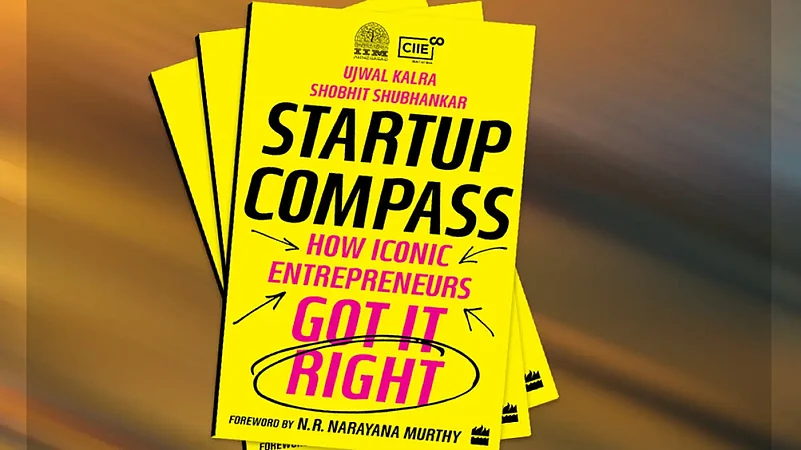As of January 2022, there were more than 61,400 start-ups recognised by the Department for Promotion of Industry and Internal Trade across the country. In 2021-22 alone, the government recognised over 14,000 new start-ups with 555 districts having at least one new start-up in 2021. At the heart of every single one of those start-ups—big and small–is an idea that it wants to execute well. In their latest book, Startup Compass-How Iconic Entrepreneurs Got It Right, authors Ujwal Kalra and Shobhit Shubhankar have spoken with 15 of India’s top start-up founders who tell them what it takes to make it big—right from the idea to the execution and the eventual exit.
Here is an excerpt from the book –
Arriving at an idea that can solve a real-world customer problem is a non-trivial proposition. TFS (TaxiForSure) founder Raghu offers three possible approaches for arriving at solutions which can become ideas for startups.
The first is to look at the problems you might be facing and see if you have any viable solutions. In this, Raghu echoes Y Combinator founder Paul Graham who holds that the way to get startup ideas is not to try to think of startup ideas. Instead, it is to look for problems, ‘preferably problems you have yourself.
Any given real-world problem can be classified either as an unmet demand or a latent need. An unmet demand exists when a market already exists, but there is a potentially better solution than those that are available. The idea itself might not be so revolutionary that it leads to the formation of a new industry, but it might be disruptive enough to alter the workings of an existing industry.
Raghu attributes WhatsApp’s successful penetration of the Indian messaging service market to its ability to provide a solution that served an existing demand in a more convenient fashion for its target customer segment. Incumbent technology companies already offered messaging platforms at the time. The market segment was closely contested by Yahoo! Messenger, Google Hangouts and Facebook Messenger. Nevertheless, WhatsApp succeeded where the others failed to take off. What allowed them to succeed was that they only asked for a phone number, not an email address. ‘India is one of those very few countries across the world where people are on the internet without an email ID,’ Raghu says. ‘That single insight gave them the entire market.’
TFS, too, did not create a new industry. It simply disrupted the existing taxi industry by offering customers the ability to book a taxi using a smartphone. ‘People were already using taxis,’ Raghu says. ‘There was already a market for people to use taxis. TFS came up with a solution that would make it a lot more convenient for people to book tax. We didn’t create the market; we didn’t build the market. When we were ideating, the market existed. But we had a better solution than what existed in the market.’
On the other hand, there are startups that tap into a hitherto unknown latent need among customers, and thereby lead to the creation of a new industry. A latent need is, by definition, not immediately observable and not explicitly known. There is no glaring hole or readily observable unmet need in the market. However, every once in a while, an idea or a product comes along that captures customer imagination in such a way that it leads to the rise of a new industry. The iPhone was such a product, entirely upturning the smartphone paradigm as it existed at the time. ‘An idea or product that addresses a latent need is rare. It requires both deep customer insights, and an ability to imagine what might appeal to customers, if offered,’ shares Raghu.
The second approach to arrive at ideas is to look at emerging areas of technology. Using these technologies, can you build applications that can address certain problems? There might be ideas that did not make sense earlier, because the technologies were not viable or the economies did not add up. But with time, these ideas might have become more viable.
Raghu gives the example of startups based on virtual reality. While early breakthroughs in virtual reality were made in the 1980s, for the longest time, the technology was not mature enough or accessible enough for a startup to be based on it. With the advent of smartphones, virtual-reality-based startups have become more viable.
Being familiar with the leading edge of rapidly changing fields makes it easier to notice technology-driven solutions to customer problems. According to Paul Graham, if you are at the leading edge of a field that’s changing fast, you are more likely to notice opportunities that others might miss. ‘If you look at the way successful founders have formulated their ideas, it’s generally the result of some external stimulus hitting a prepared mind,’ he says.
The third approach is to examine startups that are doing well in other markets, and replicate them. ‘When you look at something that might be working elsewhere, you should try to figure out what is the problem that it is essentially trying to solve,’ says Raghu. The problem that a given startup solves might not even exist in the Indian market. Or even if it does, it might vary significantly in shape and form, thereby immediately defeating the prospect of directly applying the solution to the Indian context. It is therefore crucial to customize a solution to the needs of the local market. ‘Figure out if that problem is also prevailing in Indian markets and whether the solution is a right fit for Indian markets, or something needs to change,’ Raghu says.
In starting Nykaa, Falguni Nayar took inspiration from beauty stores in the US. Both of Falguni’s children were studying in the US; in her frequent visits to the country, she had become a loyal customer of the beauty giant Sephora.4 The beauty industry in the West was huge, with entire floors of high-end department stores dedicated to cosmetics and other beauty products; she realized that it was only a matter of time before it picked up in India.
Buying beauty products in India had hitherto made for a poor experience. In contrast to their Western counterparts, Indian women still had to visit neighbourhood stores for their beauty needs. These mom-and-pop stores, mostly staffed by male owners, sold cosmetics alongside other knick-knacks. Assortments were limited, displays poor and there was no opportunity to sample products. A reliable retailer of branded cosmetics did not exist in India.
Falguni decided that an Indian version of Sephora was a timely idea; there was a clear opportunity in giving customers easy access to high-end beauty items, complete with tutorials and testimonials. However, instead of looking to replicate Sephora’s brick-and-mortar-first model, Falguni decided to set up an online retailer first; it would be less capital intensive and somewhat easier to scale. She started Nykaa as an e-commerce platform, eventually adding high-street stores once the brand became established.
Similarly, while Flipkart took inspiration from successful e-commerce businesses in developed markets, the founders needed to tailor their approach to e-commerce for the Indian market. Flipkart was founded in 2007 by Sachin Bansal and Binny Bansal, batchmates from IIT Delhi who had both worked at Amazon. They had both realized the potential of an e-commerce business in India while working at Amazon. But for the e-commerce platform to be successful, it had to be tailored for the Indian market.
When Flipkart started offering cash-on-delivery (CoD) in 2010, it was one of the earliest online retailers to embrace this innovation.6 At the time, only 0.5 per cent of the Indian population used credit cards.7 Credit cards and online banking were still nascent; most customers did not have a means to shop online. CoD allowed consumers to buy online and pay in cash only when the product was delivered. It was an industrydefining innovation that played a major role in popularizing Flipkart, and driving adoption.
While the three outlined approaches can help generate ideas, Raghu stresses upon the importance of combining them with wide-ranging discussions with peers that can drive deeper understanding and insights. ‘Ideas do not usually come when you are sitting alone or trying to ideate. Ideas originate from discussions. You just cannot get into a meeting with the agenda of getting an idea. Ideas happen,’ he says. ‘As you take part in conversations, something or the other is going to click within you. You can’t sit alone and start looking at ideas.’ Discussions lead to the distilling of thought, and can drive the uncovering of customer insights.
(Excerpted from Startup Compass-How Iconic Entrepreneurs Got It Right by Ujwal Kalra and Shobhit Shubhankar, published by HarperCollins, May 2022)
New Books On The Block
Take a look at what’s new in the business section of Amazon’s book shelf
Essentially Mira: The Extraordinary Journey Behind Forest Essentials – June 2022
Mira Kulkarni
As a single mother, what does it take to build a widely popular luxury beauty brand from scratch? Author and founder of Forest Essentials Mira Kulkarni has the answer.
UNSTARTUP: How Unacademy Ignored Conventional Advice to Become a 3x Unicorn - June 2022
Nistha Tripathi
The author walks the readers through the everyday decisions of the start-up world through the lens of Unacademy to show that there is more depth to the world than its glitz.
You Can Compound - May 2022
Vivek Mashrani
From the tricks of buying and selling to how to compound wealth by strategic investment, this book teaches you how to be a successful investor in the stock market.
Build: An Unorthodox Guide to Making Things Worth Making - May 2022
Tony Fadell
After seeing his fair share of failures, the author, inventor of the iPod and iPhone, pens down his views on what works and what needs to be done to build iconic products.
Just Keep Buying: Proven ways to save money and build your wealth – May 2022
Nick Maggiulli
The author, a finance blogger, tries to answer the tough personal finance questions while showing his readers how to build wealth efficiently.































